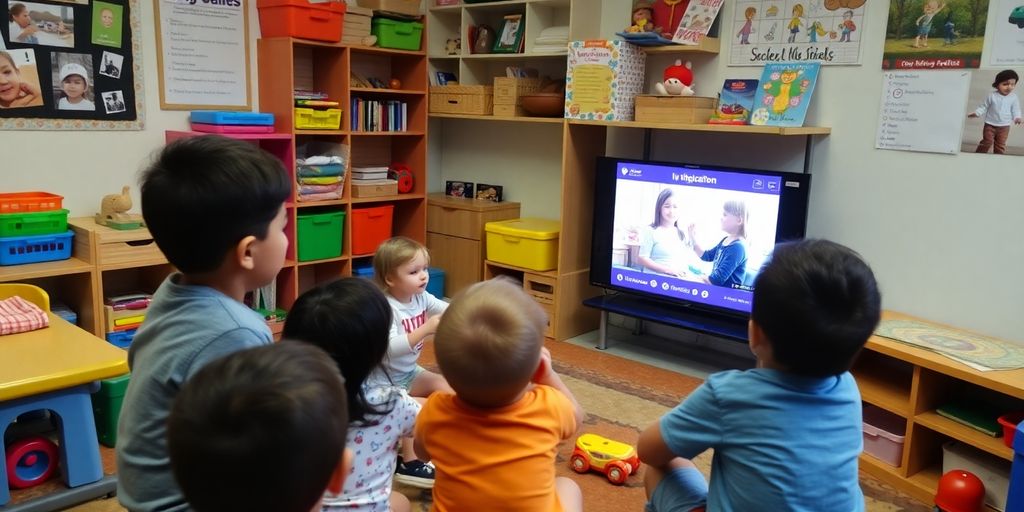Using Video Modeling to Enhance Social Skills in Autism
ABA TherapyJuly 17, 2025

Video modeling is a powerful tool that helps children with autism learn social skills and other important behaviors. By using videos, children can watch and imitate actions in a way that is both engaging and effective. This article explores how video modeling works, its benefits, and practical tips for parents and practitioners to implement it successfully.
Key Takeaways
- Video modeling helps children with autism learn by watching and copying behaviors.
- Children with autism are often visual learners, making video modeling an effective teaching method.
- Creating personalized videos can increase engagement and minimize distractions for the child.
- Video modeling can be used in various settings, including home, school, and therapy sessions.
- This approach promotes independence by allowing children to learn at their own pace.
Understanding Video Modeling in Autism

Definition and Concept
Video modeling is a teaching method that helps autistic children learn new skills by watching videos of someone performing those skills. The child then imitates what they see. This approach is effective because many autistic individuals are visual learners, meaning they understand better when they see things rather than just hearing about them.
Historical Background
Video modeling was first introduced in 1982 by researchers Monika Steinborn and Terry J. Knapp. They used videos to teach an autistic child how to cross the street safely. Since then, this method has been used by various professionals to help autistic individuals learn a wide range of skills.
Types of Video Modeling
There are four main types of video modeling:
- Basic Video Modeling: Uses adults, peers, or animations as models.
- Video Self-Modeling: Features the autistic child as the model.
- Point of View Video Modeling: Shows the task from the child's perspective, like a pair of hands completing a task.
- Video Prompting: Breaks down a task into smaller steps that the child watches as they complete it.
Type of Video ModelingDescriptionBasic Video ModelingUses other models to demonstrate skills.Video Self-ModelingThe child is the model in the video.Point of View Video ModelingShows the task from the child's viewpoint.Video PromptingBreaks tasks into steps for easier learning.
Video modeling is a powerful tool that can help autistic children learn essential skills in a fun and engaging way. This method supports social communication goals and encourages independence in daily activities.
The Science Behind Video Modeling
Visual Learning in Autism
Video modeling is a powerful tool that leverages visual learning to help children with autism. Many individuals on the spectrum learn best through visual means, making video modeling an effective strategy. By showing a behavior or skill through video, children can see exactly what is expected of them. This method can be particularly beneficial in teaching social skills, as it provides a clear example of how to interact with others.
Bandura’s Social Learning Theory
The foundation of video modeling is rooted in Bandura’s Social Learning Theory. This theory explains how people learn by observing others. It highlights four key components:
- Attention: Focusing on the model's behavior.
- Retention: Remembering the observed behavior.
- Reproduction: Practicing the behavior.
- Motivation: Wanting to imitate the behavior.
These elements work together to help learners acquire new skills by watching and imitating others.
Research Evidence Supporting Video Modeling
Numerous studies have shown that video modeling can significantly improve social skills in children with autism. For instance, a study titled "using video modeling plus feedback to teach vocational skills" demonstrated that children who engaged with video modeling showed marked improvement in their ability to perform workplace social skills. This evidence supports the idea that video modeling is not just a theoretical concept but a practical approach that yields real results in skill development.
Video modeling is a practical and effective method for skill acquisition, aligning with the unique characteristics of individuals with autism and promoting independence in their daily lives.
In summary, the science behind video modeling is grounded in visual learning and social learning theory, supported by research that highlights its effectiveness in teaching essential skills to children with autism.
Implementing Video Modeling for Skill Development
Creating Effective Videos
To create effective video modeling interventions, start by identifying the specific skill you want to teach. Here are the steps to follow:
- Identify the skill and perform a task analysis.
- Prepare the necessary materials and ensure the space is clean and organized.
- Record the demonstration using a smartphone or tablet.
- Edit the video if needed to focus on the key actions.
- Watch the video with the child and practice the skill together.
Steps for Implementation
Implementing video modeling involves several key steps:
- Select the right type of video modeling (basic, self, point-of-view, or prompting).
- Practice the skill with the child after watching the video.
- Monitor progress by collecting data on the child’s performance.
- Adjust the approach based on the child’s needs and responses.
Customizing Videos for Individual Needs
Customizing videos is essential for effective learning. Consider the following:
- Tailor the content to match the child’s interests and abilities.
- Use clear and simple language in the videos.
- Include familiar settings and people to make the videos relatable.
Video modeling offers a dynamic approach to teaching and supporting individuals with autism. By using video to demonstrate various skills and behaviors, it enhances learning and engagement.
Applications of Video Modeling in Daily Life
Teaching Daily Living Skills
Video modeling can be a powerful tool for teaching daily living skills. Through repeated exposure to video modeling examples, individuals can improve their social skills, communication abilities, and daily living skills. Here are some common daily living skills that can be taught using video modeling:
- Personal hygiene (e.g., brushing teeth, washing hands)
- Meal preparation (e.g., making a sandwich, setting the table)
- Household chores (e.g., folding laundry, cleaning up)
Enhancing Social Skills
Video modeling is also effective in enhancing social skills. By watching videos of peers engaging in social interactions, individuals can learn appropriate behaviors and responses. Some social skills that can be improved include:
- Initiating conversations
- Understanding non-verbal cues
- Taking turns in conversations
Supporting Communication Skills
In addition to social skills, video modeling can support communication skills. This method allows individuals to see and hear how to express themselves effectively. Key areas of focus include:
- Using appropriate greetings
- Asking for help
- Expressing feelings
Video modeling provides a practical and effective method for skill acquisition, aligning with the unique characteristics of individuals with autism and promoting independence in their daily lives.
Benefits and Challenges of Video Modeling
Promoting Independence
One of the primary benefits of video modeling is its ability to facilitate skill acquisition. Individuals with autism often have difficulty learning new skills, and video modeling provides a visual representation that can enhance understanding. This method allows learners to see the correct way to perform tasks, which can lead to greater independence in their daily lives.
Consistency and Generalization
Video modeling can be used across various settings, such as home, school, and community environments. This consistency helps reinforce learning and allows individuals to generalize skills to different situations. For example, a child may learn to greet peers in a video and then practice this skill in real-life interactions.
Addressing Potential Challenges
While video modeling has many advantages, there are also challenges to consider. Some potential challenges include:
- Access to technology: Not all families may have the necessary devices to utilize video modeling effectively.
- Engagement: Some children may not be motivated to watch videos, which can hinder the learning process.
- Skill complexity: If a skill is too complex, breaking it down into manageable parts may be necessary, which can require additional planning.
Video modeling is a practical and effective method for skill acquisition, aligning with the unique characteristics of individuals with autism and promoting independence in their daily lives.
Summary
In summary, video modeling offers significant benefits, such as promoting independence and ensuring consistency in learning. However, it is essential to address challenges like access to technology and maintaining engagement to maximize its effectiveness.
Practical Tips for Parents and Practitioners

Selecting Appropriate Tools
When starting with video modeling, it's important to choose the right tools. Here are some options:
- Recording Devices: Use a smartphone, tablet, or video camera.
- Editing Software: Basic editing tools can help refine your videos.
- Storage Solutions: Ensure videos are easily accessible on personal devices.
Engaging the Child
To make video modeling effective, keep the child engaged:
- Choose Relevant Skills: Focus on skills that interest the child.
- Involve the Child: Let them help in creating or selecting videos.
- Use Positive Reinforcement: Celebrate small successes to motivate them.
Monitoring Progress and Collecting Data
Tracking progress is essential for improvement:
- Data Collection: Keep records of the child's performance over time.
- Adjustments: Be ready to change videos based on the child's needs.
- Feedback: Regularly discuss progress with the child to keep them informed.
Involving parents in the video modeling process is key. They can help reinforce skills at home, ensuring consistency between therapy and daily life.
By following these practical tips, parents and practitioners can effectively use video modeling to enhance social skills in children with autism, promoting their independence and success in various settings.
Future Directions in Video Modeling Research
Emerging Trends
The field of video modeling is evolving rapidly. New methods are being developed to enhance its effectiveness. Some trends to watch include:
- Increased use of smart devices for accessibility.
- Integration of video modeling in various settings like schools and homes.
- Collaboration among therapists, teachers, and parents to create a supportive environment.
Technological Advancements
Technology plays a crucial role in the future of video modeling. Innovations may include:
- Enhanced video editing tools for better content creation.
- Use of virtual reality to simulate real-life scenarios.
- Development of apps that allow for easy sharing of video resources.
Potential Areas for Further Study
Research is ongoing, and several areas need more exploration:
- The effectiveness of video modeling for different age groups.
- Long-term impacts on social skills and independence.
- How video modeling can be adapted for nonverbal children.
As we look ahead, the potential for video modeling to improve social skills in children with autism is promising. Continued research will help refine these techniques and expand their applications.
In summary, the future of video modeling research is bright, with many opportunities for growth and improvement. The focus will be on making these interventions more effective and accessible for all children.
Conclusion
In conclusion, video modeling stands out as an effective way to help children with autism improve their social skills and daily living abilities. This method takes advantage of the fact that many kids with autism learn better through visuals. By watching videos that show how to do certain tasks, children can learn at their own pace and focus on one skill at a time. The videos can be watched repeatedly, making it easier for them to understand and remember what to do. As more professionals use video modeling, it becomes clear that this approach not only supports learning but also encourages independence. Overall, video modeling is a powerful tool that can make a real difference in the lives of children with autism.
Frequently Asked Questions
What is video modeling and how does it help children with autism?
Video modeling is a technique where children watch videos of someone performing a skill or behavior, then they try to copy it. This method is helpful for kids with autism because it allows them to learn by watching, which can be easier than learning in person.
What types of skills can be taught using video modeling?
Video modeling can be used to teach a variety of skills, including social skills, daily living skills like brushing teeth, and communication skills. It helps kids learn how to interact in different situations.
Who can use video modeling?
Anyone can use video modeling! Parents, teachers, therapists, and even the children themselves can create and use these videos to help learn new skills.
How often should a child watch the video for it to be effective?
The frequency of watching the video depends on the child's age and attention span. Younger children often benefit from watching shorter videos multiple times to help them learn.
Can video modeling be used for simple tasks?
Yes, video modeling is flexible and can be used for simple tasks, such as walking down a hallway or entering a classroom. It works well for a variety of skills.
What are the benefits of using video modeling?
Video modeling promotes independence, helps children focus, and allows them to learn at their own pace. It also provides consistent cues and can be more engaging than direct instruction.
